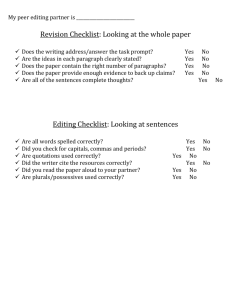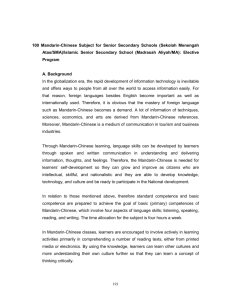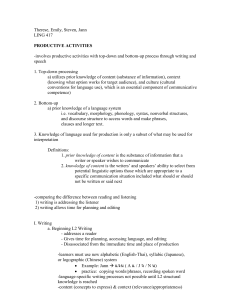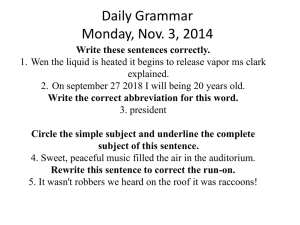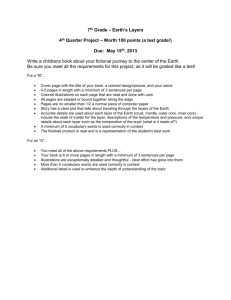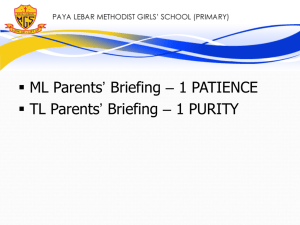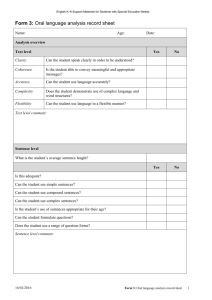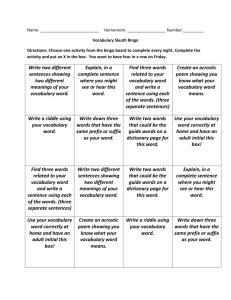99._Mandarin_Language_Program
advertisement
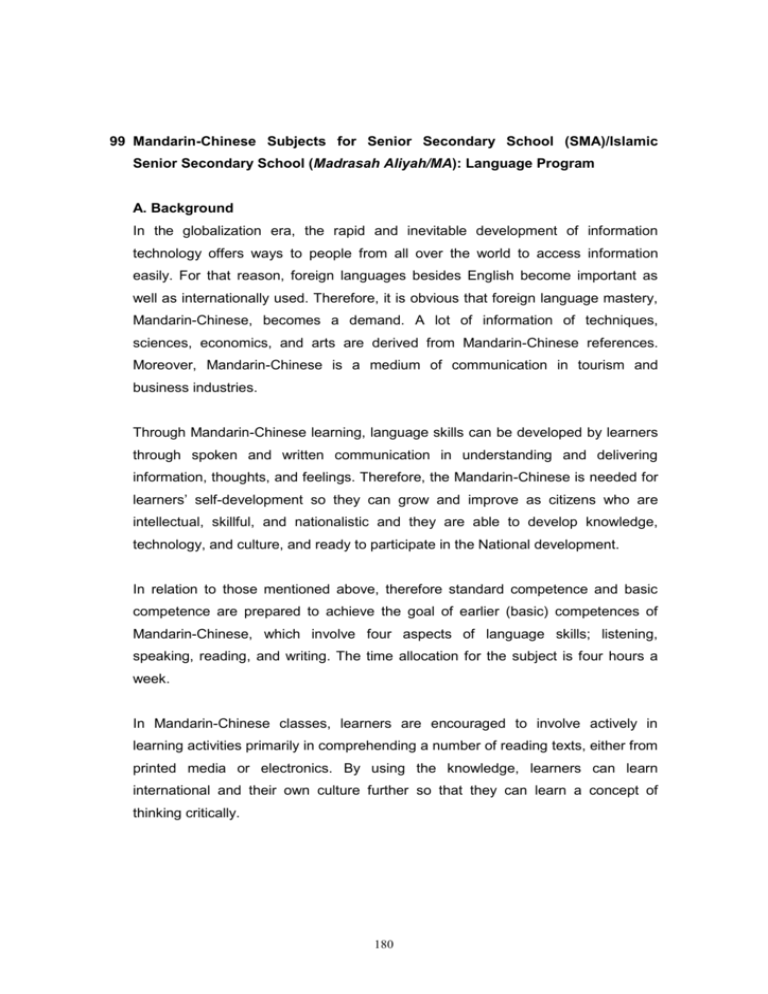
99 Mandarin-Chinese Subjects for Senior Secondary School (SMA)/Islamic Senior Secondary School (Madrasah Aliyah/MA): Language Program A. Background In the globalization era, the rapid and inevitable development of information technology offers ways to people from all over the world to access information easily. For that reason, foreign languages besides English become important as well as internationally used. Therefore, it is obvious that foreign language mastery, Mandarin-Chinese, becomes a demand. A lot of information of techniques, sciences, economics, and arts are derived from Mandarin-Chinese references. Moreover, Mandarin-Chinese is a medium of communication in tourism and business industries. Through Mandarin-Chinese learning, language skills can be developed by learners through spoken and written communication in understanding and delivering information, thoughts, and feelings. Therefore, the Mandarin-Chinese is needed for learners’ self-development so they can grow and improve as citizens who are intellectual, skillful, and nationalistic and they are able to develop knowledge, technology, and culture, and ready to participate in the National development. In relation to those mentioned above, therefore standard competence and basic competence are prepared to achieve the goal of earlier (basic) competences of Mandarin-Chinese, which involve four aspects of language skills; listening, speaking, reading, and writing. The time allocation for the subject is four hours a week. In Mandarin-Chinese classes, learners are encouraged to involve actively in learning activities primarily in comprehending a number of reading texts, either from printed media or electronics. By using the knowledge, learners can learn international and their own culture further so that they can learn a concept of thinking critically. 180 B. Goals Mandarin-Chinese language learning in Indonesia is aimed at enabling learners to have a basic competence in listening, speaking, reading, and writing for a simple communication. C. Scope of Learning Mandarin-Chinese consists of materials which involve spoken and written discourse in the form of expositions and simple dialogues about personal identity, school life, family, daily life, Interest, tourism, public services, and professions to empower four language skills which are listening, speaking, reading, and writing, and recognize Hanyu Pinyin and Hanzy letters. 181 D. Standard of Competence and Basic Competence Year XI, Semester 1 Standard of Competences Basic Competences Listening 1. Understanding spoken discourse in 1.1 Identifying sounds of Hanyu the form of expositions and simple Pinyin (Han’s modern spells) and dialogues about Personal Identity words, phrases, and sentences in and School Life. certain contexts by matching and distinguishing them correctly. 1.2 Getting general and specific information from various kinds of spoken discourses correctly. Speaking 2. Expressing simple information 2.1 Delivering information orally with orally in the form of expositions and correct Hanyu Pinyin dialogues about Personal Identity pronunciations in simple and School Life. sentences according to contexts, which reflect appropriateness and politeness in language skills. 2.2 Practicing simple dialogues fluently and correctly, which reflect appropriateness and politeness in communication skill. Reading 3. Understanding written discourse in 3.1 Pronouncing and reading the form of expositions and simple words, and sentences in Hanyu dialogues about Personal Identity Pinyin and Hanzy writing (Han’s and School Life. literacy), in simple written discourse loudly and correctly. 3.2 Identifying forms and themes of simple discourse correctly. 3.3 Getting general and specific information from simple discourses correctly. 182 Standard of Competences Basic Competences Writing 4. Mastering 50 vocabulary from Hanzy (Han’s Literacy) 4.1 Writing Hanyu Pinyin correctly. 4.2 Writing Hanzy according to bihua and bishun standard. 5. Expressing information in written 5.1 Writing words, phrase, and in the form of expositions or simple sentences with letters, spells, and dialogs about Personal Identity correct punctuations. and School Life. 5.2 Expressing information in written in the contexts of simple sentences, which reflects skills in using Hanzy, words/phrase with correct structures. 183 Year XI, 2nd Semester Standard of Competence Basic Competence Listening 6. Understanding spoken discourse in 6.1 Identifying sounds of Hanyu the form of expositions and simple Pinyin or ujaran (words, phrases dialogues about Family and Daily or sentences in certain contexts by Life. matching and distinguishing them correctly. 6.2 Getting general and specific information from various simple spoken discourses correctly. Speaking 7. Expressing information orally in the 7.1 Delivering information orally in form of expositions and simple simple sentences according to dialogues about Family and Daily contexts with Hanyu Pinyin Life. pronunciation, which reflects appropriateness and politeness in language skills. 7.2 Practicing simple dialogues fluently and correctly, which reflects appropriateness and politeness in communication skill. Reading 8. Understanding written discourse in 8.1 Reading words, phrases or the form expositions or simple sentences in Hanyu Pinyin and dialogues about Family and Daily Hanzy writing (Han’s literacy), in Life. simple written discourse loudly and correctly. 8.2 Identifying forms and themes of simple discourse correctly. 8.3 Getting general and specific information from simple written discourse correctly 184 Standard of Competence Basic Competence Writing 9. Mastering 50 vocabulary of Hanzy 9.1 Writing Hanyu Pinyin correctly. (Han’s Literacy). 9.2 Writing Hanzy according to bihua and bishun standard. 10. Expressing information in written 10.1. Writing words, phrases, and in the form of expositions and sentences in letters, spelling, simple dialogs about Family and and correct punctuations. Daily Life. 10.2 Expressing written information in simple sentences according to contexts, which reflects skills in using Hanzy, words or phrases with correct structures. 185 Year XII, 1st Semester Standard of Competence Basic Competence Listening 1. Understanding spoken discourse 1.1 Identifying sounds of Hanyu in the form of expositions and Pinyin and words, phrases and simple dialogues about Hobbies sentences in certain contexts by and Tourism. matching and distinguishing them correctly. 1.2 Getting general and specific information from various simple spoken discourses correctly. Speaking 2. Expressing information orally in 2.1 Delivering information orally with the form of expositions and simple correct pronunciation in simple dialogues about Hobbies and sentences according to contexts Tourism. with Hanyu Pinyin pronunciation, which reflects appropriateness and politeness of language skills. 2.2 Practicing simple dialogues fluently and correctly which reflects appropriateness and politeness in communication skills Reading 3. Understanding spoken discourse 3.1 Reading words, phrases or in the form of expositions and sentences in Hanyu Pinyin and simple dialogues about Hobbies Hanzy writing (Han’s Literacy) in and Tourism. simple written discourse loudly and correctly. 3.2 Identifying forms and themes of simple discourse correctly. 3.3 Getting general and specific information from simple written discourse correctly 186 Standard of Competence Basic Competence Writing 4. Mastering 120 vocabulary of Hanzy (Han’s Literacy) 4.1 Writing Hanyu Pinyin correctly. 4.2 Writing Hanzy according to bihua and bishun standard 5. Expressing information in written 5.1 Writing words, phrase, and form of expositions or simple sentences with letters, spells, and dialogs about Hobbies and correct punctuations. Tourism 5.2 Expressing information in written form according to contexts, which reflects skills in using Hanzy, words/phrase with correct structures. 5.3 Expressing opinions and feelings in written form fluently and correctly, which reflects appropriateness and politeness of language skills. 187 Year XII, 2nd Semester Standard Competences Basic Competences Listening 6. Understanding spoken discourse 6.1 Identifying sounds of Hanyu in the form of expositions and Pinyin and words, phrases and simple dialogues about Public sentences in certain contexts by Services and Professions. matching and distinguishing them correctly. 5.1 Getting general and specific information from various simple spoken discourses correctly. Speaking 7. Expressing simple information 6.1 Delivering information orally with orally in the form of expositions correct pronunciation in simple and simple dialogues about Public sentences according to contexts Services and Professions. with Hanyu Pinyin pronunciation, which reflects appropriateness and politeness of language skills. 6.2 Practicing simple dialogues fluently and correctly, which reflect appropriateness and politeness in communication skills. Reading 8. Understanding spoken discourse in 8.1 Reading words, phrases or the form of expositions and simple sentences in Hanyu Pinyin and dialogues about Public Services Hanzy writing (Han’s Literacy) and and Professions. simple written discourse loudly and correctly. 8.2 Identifying forms and themes of simple discourse correctly. 8.3 Getting general and specific information from simple written discourse correctly. 188 Standard of Competence Basic Competence Writing 9. Mastering 150 Vocabulary of Hanzy (Hans’ Literacy) 9.1 Writing Hanyu Pinyin correctly. 9.2 Writing Hanzy according to bihua and bishun standard. 10. Expressing information in written 10.1 Writing words, phrases and in the form of expositions and sentences with letters, spells, simple dialogues about Public and correct punctuations. Services and Professions. 10.2 Expressing information in written in simple sentences according to contexts, which reflects skills in using words, phrases with letters, spells, punctuations, and corrects structures. 10.3 Expressing opinions and feelings in written fluently and correctly, which reflects appropriateness and politeness in communication skills. E. Development Target Standard of Competence and basic competence are the target and basis to develop primary materials, learning activities, and the achievement indicators of assessment competence. In designing learning and assessments activities, it’s necessary to consider the Standard of Competence and Basic Competences. 189
